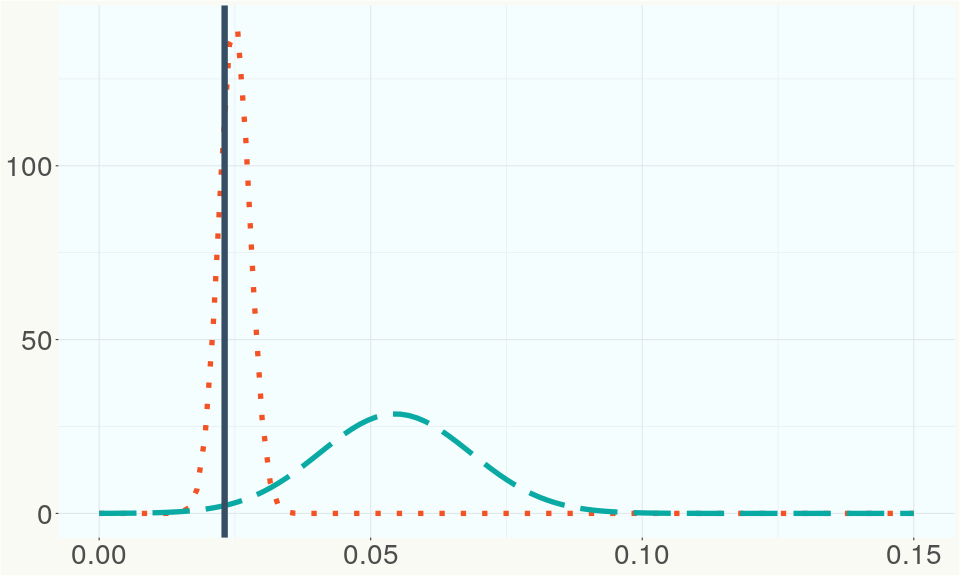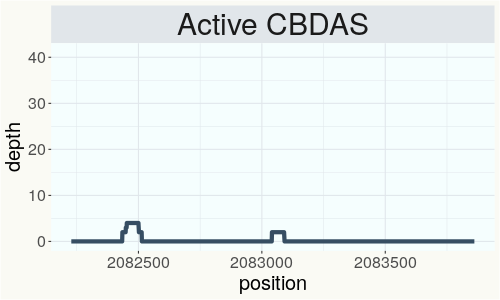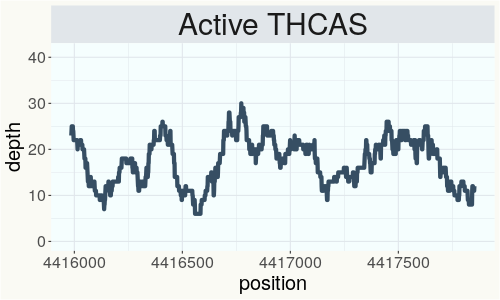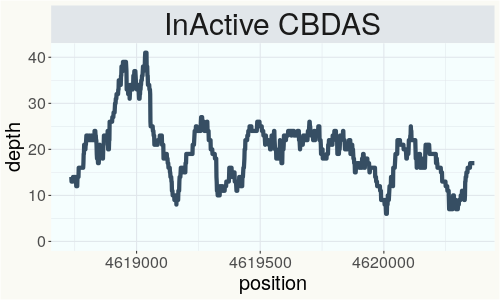CDSD
RSP 13084
Grower: Zamir Punja
General Information
- Sample Name
- CDSD - flower
- Accession Date
- February 7, 2024
- Reported Plant Sex
- Female
- Report Type
- Whole-Genome Sequencing
- Microbiome
- Krona Plot
- Fungal Microbiome
- Krona Plot
- Bacterial Microbiome
- Krona Plot
- Viral Microbiome
- Krona Plot
The strain rarity visualization shows how distant the strain is from the other cultivars in the Kannapedia database. The y-axis represents genetic distance, getting farther as you go up. The width of the visualization at any position along the y-axis shows how many strains there are in the database at that genetic distance. So, a common strain will have a more bottom-heavy shape, while uncommon and rare cultivars will have a visualization that is generally shifted towards the top.
Chemical Information
Cannabinoid and terpenoid information provided by the grower.
Cannabinoids
No information provided.
Terpenoids
No information provided.
Genetic Information
- Plant Type
- Type I
File Downloads
The bell curve in the heterozygosity visualization shows the distribution of heterozygosity levels for cannabis cultivars in the Kannapedia database. The green line shows where this particular strain fits within the distribution. Heterozygosity is associated with heterosis (aka hybrid vigor) but also leads to the production of more variable offspring. When plants have two genetically different parents, heterozygosity levels will be higher than if it has been inbred or backcrossed repeatedly.
The ratio of reads mapped to Y-contigs to reads mapped to the whole Cannabis genome (Y-ratios) has been demonstrated to be strongly correlated with plant sex typing. This plot shows the distribution of Y-ratios for all samples in our database which were sequenced with the same method (panel or WGS) as this sample and where this sample falls in the distribution.

This chart represents the Illumina sequence coverage over the Bt/Bd allele. These are the three regions in the cannabis genome that impact THCA, CBDA, CBGA production. Coverage over the Active CBDAS gene is highly correlated with Type II and Type III plants as described by Etienne de Meijer. Coverage over the THCA gene is highly correlated with Type I and Type II plants but is anti-correlated with Type III plants. Type I plants require coverage over the inactive CBDA loci and no coverage over the Active CBDA gene. Lack of coverage over the Active CBDA and Active THCA allele are presumed to be Type IV plants (CBGA dominant). While deletions of entire THCAS and CBDAS genes are the most common Bt:Bd alleles observed, it is possible to have plants with these genes where functional expression of the enzyme is disrupted by deactivating point mutations (Kojoma et al. 2006).



This chart represents the Illumina sequence coverage over the CBCA synthase gene.

Variants (THCAS, CBDAS, and CBCAS)
Variants (Select Genes of Interest)
| PKSG-2b | c.31A>T | p.Thr11Ser | missense variant | moderate | contig700 | 1951851 | T/A | |
| DXR-2 | c.1319T>C | p.Ile440Thr | missense variant | moderate | contig380 | 285250 | A/G |
|
| DXR-2 | c.431C>G | p.Ala144Gly | missense variant | moderate | contig380 | 287760 | G/C | |
| FAD2-2 | c.367G>T | p.Gly123Cys | missense variant | moderate | contig83 | 1803002 | C/A |
|
| FAD2-2 | c.196T>C | p.Phe66Leu | missense variant | moderate | contig83 | 1803173 | A/G |
|
| FAD2-2 | c.172G>T | p.Asp58Tyr | missense variant | moderate | contig83 | 1803197 | C/A |
|
| FAD2-2 | c.164A>G | p.His55Arg | missense variant | moderate | contig83 | 1803205 | T/C |
|
| FAD2-2 | c.161T>A | p.Leu54His | missense variant | moderate | contig83 | 1803208 | A/T |
|
| FAD2-2 | c.64G>T | p.Ala22Ser | missense variant | moderate | contig83 | 1803305 | C/A |
|
| ELF3 | c.520A>C | p.Asn174His | missense variant | moderate | contig97 | 242226 | A/C | |
| ELF3 |
c.1230-2_123 |
splice acceptor variant & intron variant | high | contig97 | 243676 | TAG/T | ||
| ELF3 | c.1966C>G | p.Pro656Ala | missense variant | moderate | contig97 | 244797 | C/G | |
| ELF3 | c.2198G>T | p.Arg733Leu | missense variant | moderate | contig97 | 245029 | G/T | |
| aPT4 | c.216A>T | p.Lys72Asn | missense variant | moderate | contig121 | 2828872 | A/T |
|
| aPT1 | c.406A>G | p.Ile136Val | missense variant | moderate | contig121 | 2839605 | A/G | |
| HDS-2 |
c.82_93delGT |
p.Val28_Thr3 |
conservative inframe deletion | moderate | contig95 | 1989748 |
CGTAACCGGAAC |
|
| HDS-2 | c.127T>G | p.Ser43Ala | missense variant | moderate | contig95 | 1989794 | T/G |
|
| HDS-2 | c.1179delC | p.Ser394fs | frameshift variant | high | contig95 | 1991586 | TC/T |
|
| AAE1-2 | c.331A>G | p.Asn111Asp | missense variant | moderate | contig81 | 209293 | A/G |
|
| AAE1-2 | c.1118C>G | p.Thr373Ser | missense variant | moderate | contig81 | 210080 | C/G |
|
| AAE1-2 | c.1541T>C | p.Val514Ala | missense variant | moderate | contig81 | 210503 | T/C |
|
| PHL-1 | c.2623A>G | p.Thr875Ala | missense variant | moderate | contig1439 | 1487174 | T/C |
|
| PHL-1 | c.2551A>G | p.Thr851Ala | missense variant | moderate | contig1439 | 1487246 | T/C | |
| FAD4 | c.121G>T | p.Val41Phe | missense variant | moderate | contig784 | 1690873 | G/T |
|
| HDS-1 | c.1618A>G | p.Ile540Val | missense variant | moderate | contig1891 | 885936 | T/C | |
| HDS-1 | c.56C>G | p.Ala19Gly | missense variant | moderate | contig1891 | 889336 | G/C | |
| HDS-1 | c.35G>A | p.Cys12Tyr | missense variant | moderate | contig1891 | 889357 | C/T | |
| PIE1-2 | c.1872T>A | p.Asp624Glu | missense variant | moderate | contig1460 | 1190252 | A/T | |
| PIE1-2 | c.1678G>T | p.Glu560* | stop gained | high | contig1460 | 1191552 | C/A |
|
| PIE1-2 | c.637T>A | p.Ser213Thr | missense variant | moderate | contig1460 | 1194421 | A/T | |
| FT | c.240C>G | p.Asn80Lys | missense variant | moderate | contig1561 | 3124664 | C/G |
|
| FLD | c.2981T>C | p.Met994Thr | missense variant | moderate | contig1450 | 2044012 | A/G | |
| FLD | c.2964C>A | p.Asp988Glu | missense variant | moderate | contig1450 | 2044029 | G/T | |
| FLD | c.2929T>C | p.Phe977Leu | missense variant | moderate | contig1450 | 2044103 | A/G | |
| PIE1-1 | c.100G>A | p.Glu34Lys | missense variant | moderate | contig1225 | 2277786 | G/A | |
| PIE1-1 | c.1222C>G | p.Gln408Glu | missense variant | moderate | contig1225 | 2281482 | C/G | |
| GGR | c.704A>T | p.His235Leu | missense variant | moderate | contig2282 | 549696 | A/T |
|
Nearest genetic relatives (All Samples)
- 0.070 CDSD (RSP12929)
- 0.092 CDSD (RSP12935)
- 0.177 Super Runtz (RSP12810)
- 0.179 Rootbeer Rolex 50 (RSP12645)
- 0.181 SFVxTK (RSP11072)
- 0.186 Skywalker OG (RSP10837)
- 0.188 Purple Urkle (RSP12890)
- 0.191 Noetic OG (RSP11455)
- 0.193 Red Eye OG (RSP11190)
- 0.195 Gorilla Cookies (RSP11231)
- 0.197 RKM-2018-013 (RSP11104)
- 0.197 East side OG (RSP12089)
- 0.199 Styrofoam Cup x Diesel Truck OG 16 (RSP12972)
- 0.200 East Coast Sour Diesel (RSP12922)
- 0.203 RKM-2018-026 (RSP11118)
- 0.205 Styrofoam Cup x Pearadise 6 (RSP12986)
- 0.206 Eucalyptus (RSP12803)
- 0.206 Cherry Lime Runtz (RSP12486)
- 0.209 Deadhead OG (RSP11463)
- 0.211 Garlic (RSP11341)
Most genetically distant strains (All Samples)
- 0.492 Cherry Blossom (RSP11306)
- 0.484 Jamaican Lion (RSP12916)
- 0.471 Cherry Blossom (RSP11325)
- 0.465 Cherry Blossom (RSP11318)
- 0.463 Cherry Blossom (RSP11322)
- 0.461 JL yellow (RSP11075)
- 0.461 Jamaican Lion (RSP12917)
- 0.454 Tanao Sri 46 (RSP11486)
- 0.451 Ringo s Gift Katie s Cut (RSP11624)
- 0.451 Cherry Blossom (RSP11329)
- 0.449 AVIDEKEL 2 0 (RSP11174)
- 0.447 Jamaican Lion (RSP12915)
- 0.447 JL 3rd Gen Mother (RSP11214)
- 0.446 CBD2 V 2 (RSP12669)
- 0.445 Northern Skunk (RSP11456)
- 0.443 Wife (RSP11148)
- 0.439 Cherry Blossom (RSP11315)
- 0.439 Cherry Blossom (RSP11323)
- 0.435 Cherry Blossom (RSP11300)
- 0.434 Brunswick High (RSP11164)
Nearest genetic relative in Phylos dataset
- Overlapping SNPs:
- 88
- Concordance:
- 64
Nearest genetic relative in Lynch dataset
- Overlapping SNPs:
- 3
- Concordance:
- 3
Blockchain Registration Information
- Transaction ID
-
d68fc21fd12f0b0c
da1d909623138a76 98959296ef24f737 f3a42ba3bd3baf35 - Stamping Certificate
- Download PDF (39.5 KB)
- SHASUM Hash
-
58ef74134f68010fae1c6e699e8e2775 cedba82ffe55d972 15d18cfea5cdec5a